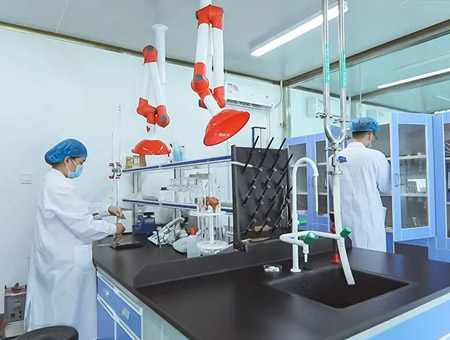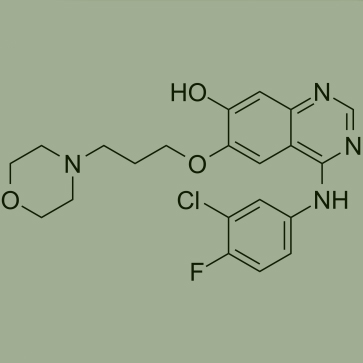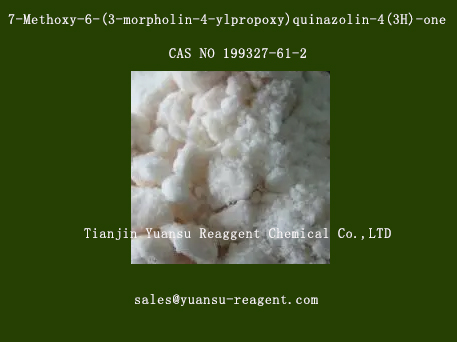7-Methoxy-6-(3-morpholin-4-ylpropoxy)quinazolin-4(3H)-one
What is 7-Methoxy-6-(3-morpholin-4-ylpropoxy)quinazolin-4(3H)-one, cas no. 199327-61-2,a producer telling you the result.
CAS NO. 199327-61-2
If you need the products .Please send your inquiry to us through e-mail: sales@yuansu-reagent.com
To begin with, let us tell you what is the basic information of 7-Methoxy-6-(3-morpholin-4-ylpropoxy)quinazolin-4(3H)-one CAS NO. 199327-61-2?
|
Molecular Formula |
C16H21N3O4 |
Molecular Weight |
319.356 |
|
Density |
1.3±0.1 g/cm3 |
Boiling Point |
564.4±50.0 °C at 760 mmHg |
|
Flash Point |
295.2±30.1 °C |
Exact Mass |
319.153198 |

Like many stuff, it has many synonyms as follows
|
Gefitinib Impurity 17 |
|
7-Methoxy-6-[3-(morpholin-4-yl)propoxy]quinazolin-4(3H)-one |
|
7-Methoxy-6-[3-(4-morpholinyl)propoxy]-4(1H)-quinazolinone |
| 4(3H)-Quinazolinone, 7-methoxy-6-[3-(4-morpholinyl)propoxy]- |
First, the chemical is very special, some technical indexes as below
If you need the products .Please send your inquiry to us through e-mail: sales@yuansu-reagent.com
Calculate chemical data
1. Reference value for hydrophobic parameter calculation (XlogP): 0.7
2. Number of hydrogen bond donors: 1
3. Number of hydrogen bond acceptors: 5
4. Number of rotatable chemical bonds: 6
5. Number of tautomers: 3
6. Topological molecular polarity surface area: 72.4
7. Number of heavy atoms: 23
8. Surface charge: 0
9. Complexity: 426
10. Number of isotopic atoms: 0
11. Determine the number of atomic stereocenters: 0
12. Uncertain number of atomic stereocenters: 0
13. Determine the number of chemical bond stereocenters: 0
14. Number of uncertain chemical bond stereocenters: 0
15. Number of covalent bond units: 1
Second, the Synthetic Route we will recommend is the most important for your reference?
First, synthesis line of 7-Methoxy-6-(3-morpholin-4-ylpropoxy)quinazolin-4(3H)-one CAS NO. 199327-61-2 as follows


Synthetic route design
1. Selection of starting materials
Benzene derivatives: Choose a suitable benzene ring derivative as the starting material, which should contain the main substituents on the benzene ring in the target molecule.
Protective groups: If there are functional groups in the target molecule that are sensitive to subsequent reactions (such as hydroxyl, amino, etc.), protective groups need to be introduced at these positions.
2. Build the core skeleton
Constructing benzene ring substituents: Introducing the desired substituents onto the benzene ring through substitution reactions such as halogenation, nitration, sulfonation, etc.
Constructing amide bonds: If the target molecule contains amide bonds, they can be constructed through the reaction of acyl chloride with amine (amidation reaction). Firstly, convert the carboxyl group on the benzene ring into acyl chloride, and then react with the corresponding amine.
3. Introduce other functional groups
Alkylation: If the target molecule contains alkyl substituents, they can be introduced through alkylation reactions such as Friedel Crafts alkylation.
Halogen substitution: If halogen atoms need to be introduced, it can be achieved through halogenation reaction.
Remove protective groups: If protective groups were previously introduced, they now need to be removed to expose the original functional groups.
4. Fine tuning
Reduction: If there are unsaturated bonds (such as carbon carbon double bonds, carbon oxygen double bonds, etc.) in the target molecule, these bonds can be saturated through a reduction reaction.
Oxidation: On the contrary, if it is necessary to introduce functional groups such as carbonyl groups, it can be achieved through oxidation reactions.
Rearrangement: In some cases, it may be necessary to adjust the molecular skeleton structure through rearrangement reactions.
5. Purification and characterization
Purification: Purify the target product through methods such as crystallization, distillation, and chromatographic separation.
Characterization: Use NMR, IR, MS and other spectroscopic methods to characterize the product and confirm its structure.
Third, what is the usage of 7-Methoxy-6-(3-morpholin-4-ylpropoxy)quinazolin-4(3H)-one CAS NO. 199327-61-2 ? pleas see below
If you need the products .Please send your inquiry to us through e-mail:sales@yuansu-reagent.com
Usage of 199327-61-2 is to serve as a reference substance for impurity A in gefitinib for HPLC qualitative identification.
Impurity A of gefitinib is a reference substance mainly used for qualitative identification in high-performance liquid chromatography (HPLC). This reference substance is packaged in brown penicillin bottles, with a specification of 20mg/vial, and needs to be stored at 10-30 ℃ under light shielding and sealed conditions. No drying treatment is required before use, and the reference substance remains valid until the national drug standard substance is notified of discontinuation. This reference substance is provided by the China National Institute for Food and Drug Control and is located at No. 2-1, Tiantan Xili, Dongcheng District, Beijing.
In addition, the CAS number of impurity A in gefitinib is 199327-61-2, and its uses also include serving as a standard substance for quality control and testing method development to ensure the quality and safety of the drug. This reference substance plays an important role in drug development and production processes, helping to ensure product purity and compliance with relevant standards
Other usages as below
Used for the synthesis of Gefitinib Cas no. 184475-35-2
Used for the synthesis of 4-(3-chloro-4-fluoroanilino)-6-(3-morpholin-4-ylpropoxy)-1H-quinazolin-7-one
Cas no. 847949-49-9

Besides Safety Information of 7-Methoxy-6-(3-morpholin-4-ylpropoxy)quinazolin-4(3H)-one CAS NO.199327-61-2 is also important when handling it
|
Hazard Codes |
Xi |
|
WGK Germany |
3 |
|
H.S.Code: |
2934 9990.99 |
|
TSCA |
Yes |
|
HazardClass |
IRRITANT |
What is the appearance of 7-Methoxy-6-(3-morpholin-4-ylpropoxy)quinazolin-4(3H)-one CAS NO.199327-61-2? Please see the picture of 7-Methoxy-6-(3-morpholin-4-ylpropoxy)quinazolin-4(3H)-one CAS NO.199327-61-2, below
If you need the products .Please send your inquiry to us through e-mail: sales@yuansu-reagent.com
Specification of 7-Methoxy-6-(3-morpholin-4-ylpropoxy)quinazolin-4(3H)-one CAS NO.199327-61-2, is below
Apperance: white to light yellow crystal solid
Assay: 98 min by HPLC
IR identity: conform
Water:0.5% max by K.F.
Reference of Article cited for your reference below,
(1)
Synthesis of Propargyl Compounds and Their CytotoxictttActivity
Publication Name: Russian Journal of Organic Chemistry
Publication Date: 2021-03
DOI: 10.1134/s1070428021030192
(2)
Synthesis from N-Acylarylamines and Hexamethylenetetramine
Publication Name: Science of Synthesis
Publication Date: 2015
(3)
Synthesis of Propargyl Compounds and Their CytotoxictttActivity
Publication Date: 2021
Publication Name: Russian Journal of Organic Chemistry



